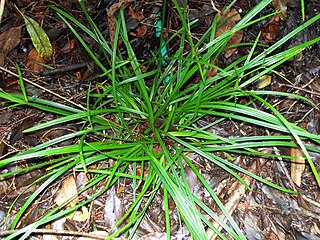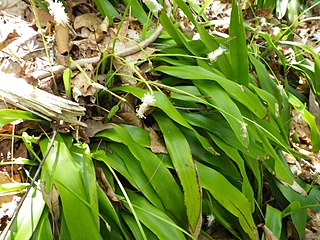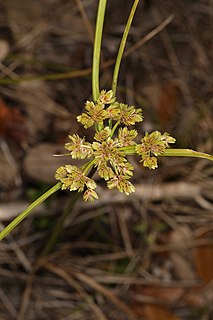
The Cyperaceae are a family of graminoid (grass-like), monocotyledonous flowering plants known as sedges. The family is large, with some 5,500 known species described in about 90 genera, the largest being the "true sedges" genus Carex with over 2,000 species.

Cyperus is a large genus of about 700 species of sedges, distributed throughout all continents in both tropical and temperate regions.

Rhynchospora is a genus of about 400 species of sedges with a cosmopolitan distribution. The genus includes both annual and perennial species, mostly with erect 3-sided stems and 3-ranked leaves. The achenes bear a beak-like tubercule and are sometimes subtended by bristles. Many of the species are similar in vegetative appearance, and mature fruits are needed to make a positive identification.

Cyperus polystachyos, also known as Pycreus polystachyos, and also called manyspike flatsedge in the US, or bunchy sedge, coast flatsedge, many-spiked sedge or Texas sedge in Australia, is a herbaceous species in the family Cyperaceae, widespread in tropical and subtropical areas around the world, sometimes extending its range into temperate regions.

Hypolytrum is a genus of plant in the family Cyperaceae. It contains approximately 60–70 species, native to tropical Africa, Asia, Australia, Latin America and various oceanic islands.
Mapania is a genus of plants in the family Cyperaceae. It contains around 60-70 species, distributed in tropical regions of Africa, India, southern China, Southeast Asia, New Guinea, Australia, Central America, northern South America, and various oceanic islands.

Fimbristylis is a genus of sedges. A plant in this genus may be known commonly as a fimbry or fimbristyle. There are 200 to 300 species distributed worldwide. Several continents have native species but many species have been introduced to regions where they are not native. Some are considered weeds. These are typical sedges in appearance, with stiff, ridged stems and cone-shaped terminal panicles of spikelets. They are found in wet environments, and are most diverse in tropical and subtropical regions.

Cyperus difformis is a species of sedge known by several common names, including variable flatsedge, smallflower umbrella-sedge and rice sedge. This plant is native to southern Europe, most of Africa and Asia, and Australia, and it is naturalized in other areas of the world, including large parts of the Americas.
Cyperus niger is a species of sedge known by the common name black flatsedge. This plant is native to the Americas, where it can be found in wet areas from South and Central America to the southwestern United States, from California and Oklahoma south to Argentina.

Dulichium is a monotypic genus of sedge containing the single species Dulichium arundinaceum, which is known by the common name threeway sedge. This is an aquatic or semi-aquatic plant of the lakes, streams, and ponds of the United States and Canada It has a wide distribution across the two countries, though noticeably absent from the Dakotas and from the Southwestern Deserts.

Ficinia is a genus of tufted or rhizomatous sedges. There are around 70 recognised species in Africa, four species that occur in New Zealand and a single species Ficinia nodosa that occurs in Australia.
Mesomelaena is a genus of sedges. It has 5 known species, all endemic to Western Australia.

Cyperus laevigatus is a species of sedge known by the common name smooth flatsedge.
Fimbristylis polytrichoides is a species of fimbry known by the common name rusty sedge, native to east Africa, Madagascar, China, Southeast Asia, New Guinea and Australia. The plant is common along the coast line and estuaries of Australia. The flowers are a distinctive rusty brown color appearing on a single spikelet from May to July.

Cyperus tetraphyllus is a sedge endemic to Australia. This grass like plant is closely related to the papyrus. It grows to 50 cm high. The habitat is eastern Australia in high rainfall areas. Found in and near rainforest from Kiama north to Queensland.

Lepironia is a genus of the sedge family, comprising only one species, Lepironia articulata, known as the grey sedge. It is found in Madagascar, India, Sri Lanka, southern China, Southeast Asia, New Guinea, and various islands of the western Pacific. It also occurs in northern and eastern Australia, as far south as Thirlmere Lakes National Park in New South Wales.

Coleochloa is a plant genus in the family Cyperaceae. It is found in sub-Saharan Africa and on the Island of Madagascar.

Carex fraseriana is a perennial member of the sedge family with the common name Fraser's sedge. It was the only species of the genus Cymophyllus before it was re-transferred to Carex.
Cyperus pulchellus is a sedge of the family Cyperaceae that is native to northern Australia, tropical Africa, northwest Madagascar and Southeast Asia.

Cyperus surinamensis, also known as the tropical flatsedge, is a sedge of the family Cyperaceae that is native to the Americas.














